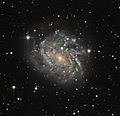Dorado (constellation) facts for kids
| Constellation | |

List of stars in Dorado
|
|
| Abbreviation | Dor |
|---|---|
| Genitive | Doradus |
| Pronunciation | genitive |
| Symbolism | the swordfish |
| Right ascension | 5 |
| Declination | −65 |
| Quadrant | SQ1 |
| Area | 179 sq. deg. (72nd) |
| Main stars | 3 |
| Bayer/Flamsteed stars |
14 |
| Stars with planets | 5 |
| Stars brighter than 3.00m | 0 |
| Stars within 10.00 pc (32.62 ly) | 0 |
| Brightest star | α Dor (3.27m) |
| Messier objects | 0 |
| Meteor showers | None |
| Bordering constellations |
Caelum Horologium Reticulum Hydrus Mensa Volans Pictor |
| Visible at latitudes between +20° and −90°. Best visible at 21:00 (9 p.m.) during the month of January. |
|
Dorado is a small but interesting constellation in the southern sky. It's often called "the swordfish" because of its shape. Constellations are groups of stars that seem to form a pattern when we look at them from Earth. Dorado is a great constellation to learn about if you're interested in space!
Contents
Dorado: The Swordfish Constellation
The constellation Dorado was first drawn on maps in the late 1500s. It was named by Dutch explorers Pieter Dirkszoon Keyser and Frederick de Houtman. They explored the southern seas and mapped many new stars. Dorado is one of 12 constellations named after animals that live in the water.
This constellation is quite small, ranking 72nd in size among all 88 constellations. It covers an area of 179 square degrees in the night sky.
Finding Dorado in the Sky
Dorado is located in the southern part of the sky. This means you need to be in the Southern Hemisphere to see it clearly. People living in places like Australia, South Africa, or South America can easily spot it. It's best seen during the month of January.
Dorado is surrounded by other constellations. These include Caelum, Horologium, Reticulum, Hydrus, Mensa, Volans, and Pictor.
Stars and Deep-Sky Wonders
Even though Dorado is small, it has some interesting features. Its brightest star is called Alpha Doradus. This star shines with a brightness of 3.27 magnitude. It is about 176 light-years away from Earth.
One of the most famous objects in Dorado is not a star, but a whole galaxy!
The Large Magellanic Cloud
A very special object found partly within Dorado is the Large Magellanic Cloud (LMC). This is a dwarf galaxy that orbits our own Milky Way galaxy. It's one of the closest galaxies to us.
The Large Magellanic Cloud looks like a cloudy patch in the night sky. It's so bright that you can see it without a telescope if you are in a dark area. It's a fantastic place to study how stars are born and how galaxies interact.
Another interesting object in Dorado is NGC 1672. This is a beautiful spiral galaxy that you can see with a good telescope. It has bright arms filled with young, blue stars.
Images for kids
See also
 In Spanish: Dorado (constelación) para niños
In Spanish: Dorado (constelación) para niños



